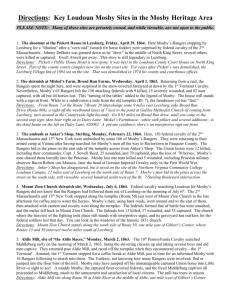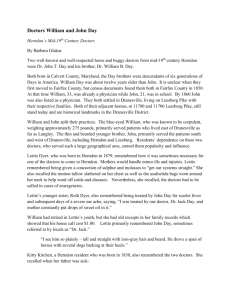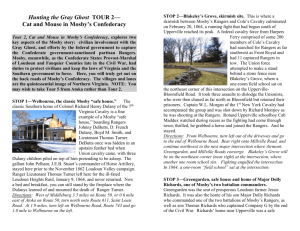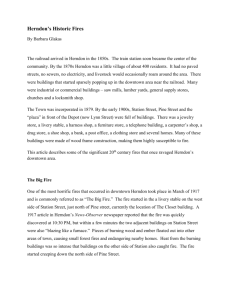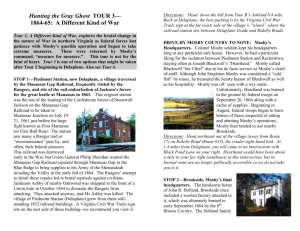St. Patrick Day Herndon Raid Reenactment, March 17, 2013 On
advertisement
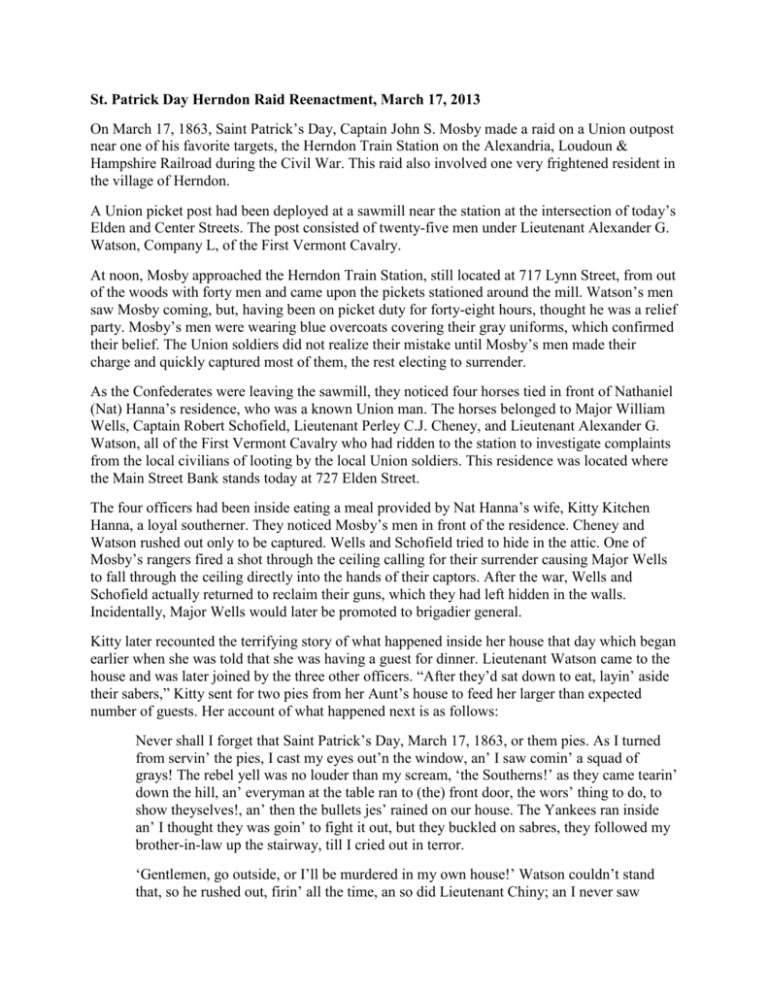
St. Patrick Day Herndon Raid Reenactment, March 17, 2013 On March 17, 1863, Saint Patrick’s Day, Captain John S. Mosby made a raid on a Union outpost near one of his favorite targets, the Herndon Train Station on the Alexandria, Loudoun & Hampshire Railroad during the Civil War. This raid also involved one very frightened resident in the village of Herndon. A Union picket post had been deployed at a sawmill near the station at the intersection of today’s Elden and Center Streets. The post consisted of twenty-five men under Lieutenant Alexander G. Watson, Company L, of the First Vermont Cavalry. At noon, Mosby approached the Herndon Train Station, still located at 717 Lynn Street, from out of the woods with forty men and came upon the pickets stationed around the mill. Watson’s men saw Mosby coming, but, having been on picket duty for forty-eight hours, thought he was a relief party. Mosby’s men were wearing blue overcoats covering their gray uniforms, which confirmed their belief. The Union soldiers did not realize their mistake until Mosby’s men made their charge and quickly captured most of them, the rest electing to surrender. As the Confederates were leaving the sawmill, they noticed four horses tied in front of Nathaniel (Nat) Hanna’s residence, who was a known Union man. The horses belonged to Major William Wells, Captain Robert Schofield, Lieutenant Perley C.J. Cheney, and Lieutenant Alexander G. Watson, all of the First Vermont Cavalry who had ridden to the station to investigate complaints from the local civilians of looting by the local Union soldiers. This residence was located where the Main Street Bank stands today at 727 Elden Street. The four officers had been inside eating a meal provided by Nat Hanna’s wife, Kitty Kitchen Hanna, a loyal southerner. They noticed Mosby’s men in front of the residence. Cheney and Watson rushed out only to be captured. Wells and Schofield tried to hide in the attic. One of Mosby’s rangers fired a shot through the ceiling calling for their surrender causing Major Wells to fall through the ceiling directly into the hands of their captors. After the war, Wells and Schofield actually returned to reclaim their guns, which they had left hidden in the walls. Incidentally, Major Wells would later be promoted to brigadier general. Kitty later recounted the terrifying story of what happened inside her house that day which began earlier when she was told that she was having a guest for dinner. Lieutenant Watson came to the house and was later joined by the three other officers. “After they’d sat down to eat, layin’ aside their sabers,” Kitty sent for two pies from her Aunt’s house to feed her larger than expected number of guests. Her account of what happened next is as follows: Never shall I forget that Saint Patrick’s Day, March 17, 1863, or them pies. As I turned from servin’ the pies, I cast my eyes out’n the window, an’ I saw comin’ a squad of grays! The rebel yell was no louder than my scream, ‘the Southerns!’ as they came tearin’ down the hill, an’ everyman at the table ran to (the) front door, the wors’ thing to do, to show theyselves!, an’ then the bullets jes’ rained on our house. The Yankees ran inside an’ I thought they was goin’ to fight it out, but they buckled on sabres, they followed my brother-in-law up the stairway, till I cried out in terror. ‘Gentlemen, go outside, or I’ll be murdered in my own house!’ Watson couldn’t stand that, so he rushed out, firin’ all the time, an so did Lieutenant Chiny; an I never saw either one on’em again, but I knew they’d been caught. Watson was a Vermonter, who was never more seen in these parts. The other two officers followed my brother-in-law to the garret (attic), which was floored all over an’ had a big brick chimney runnin’ through the roof; an’ behin’ that chimney was a dark cuddy protected by a closet on one side, with only three boards for floorin.’ The three men crawled in there, an’ while they was hidin,’ Mother an’ me ran over to Betsy Allen’s. I looked down toward (the) mill an’ saw the line of boys in blue standin’ with their sabres up, an’ I felt sure they would all be kilt, so I turned my back not to see it, leavin’ those men hidin’ in the attic. We could hear the Southerns rush in the house shootin’ and bangin,’ an’ I felt certain no one would be lef’ alive. What did happen, my brother-in-law told me afterwards. Mosby’s men rushed upstairs callin’ them to surrender, which as the bullets whizzed ‘round, they decided to do, an’ they was taken prisoners of war. Nat’s brother was lef’ there, he not bein’ in army, an’ also known to Mosby’s men, who took off with the Yankee officers an’ (their) beautiful horses to someplace beyond the Union lines. I went creepin’ home, expectin’ to see dead men at every step, but I found none. Some of the Vermont men did escape. One started back to Dranesville for help. Lieutenant Edwin H. Higley, also of the First Vermont Cavalry, hearing the gunfire hurried towards the station. He met the one Vermonter to escape two miles back towards Dranesville. Higley gave chase to Mosby as far as Horsepen Run southwest of the station. Here, some of Mosby’s men opened fire and Higley retreated. Union outposts at Herndon Station and Dranesville were subsequently moved across Difficult Run closer to Fairfax Court House. Within a couple of weeks, Mosby’s men rode by again, stopping at the Herndon Station across the street from Kitty’s house, “but the leader rode into our yard an’ lef’ his horse standin,’ an’ knocked at the front door. ‘Madam,’ he says, ‘I come to apologize to you for my men shootin’ at your house a week or so back.’ ‘So they did,” I replied, but said no more.” ‘Can you let me have a newspaper to read, Madam?’ (There was a pile inside but I answered,) ‘No, sir, I can’t.’ Mosby was too polite to insist, an’ he turned an’ walked away. I never saw him after, but in his book he called me a ‘Union woman’; he little knew how my heart was torn to pieces. I wished harm to nobody, an’ cared for many a soldier, Northern an’ Southern alike. I grew nervous seein’ scouts at all hours, an’ soldiers rushin’ by with bayonets pointed at my home. But I let that pass, an’ bygones be bygones.” Excerpt from “A Tour Guide and History of Col. John S. Mosby’s Operations in Fairfax County, Virginia” written and complied by Don Hakenson and Chuck Mauro. Please join us on the 150th anniversary of this raid for two reenactments at 11:00 am and 2:00 pm on St. Patrick’s Day, March 17, 2013 at the Herndon Train Station, 717 Lynn Street. For further information, please contact: Richard F. Downer, Co-Chairman Mosby's Herndon Station Raid 2013 Reenactment c/o Herndon Historical Society 717 Lynn Street PO Box 99 Herndon, VA 20172-0099 M: 703-795-3964 E-mail: rfdowner@gmail.com Photos: Kitty Kitchen Hanna Major William Wells, First Vermont Cavalry, USA, c 1863 Lt. Edwin Higley, First Vermont Cavalry, USA Second Lieutenant Perley C. J. Cheney, First Vermont Cavalry, USA Major Robert Schofield, First Vermont Cavalry, USA Earliest known picture of the Herndon Train Station John S. Mosby







